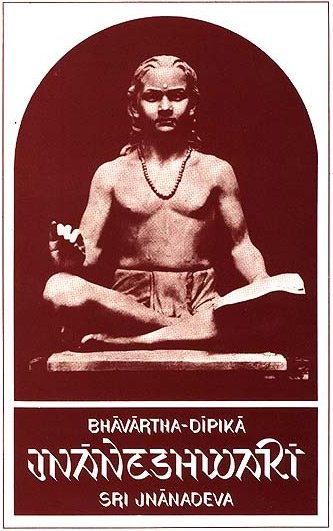Jnaneshwari (Bhavartha Dipika)
by Ramchandra Keshav Bhagwat | 1954 | 284,137 words | ISBN-10: 8185208123 | ISBN-13: 9788185208121
This is verse 13.13 of the Jnaneshwari (Bhavartha-Dipika), the English translation of 13th-century Marathi commentary on the Bhagavad-Gita.—The Dnyaneshwari (Jnaneshwari) brings to light the deeper meaning of the Gita which represents the essence of the Vedic Religion. This is verse 13 of the chapter called Kshetra and Kshetrajna Yoga.
Verse 13.13
Verse 13.13: “Having hands and feet on every side (of us), having eyes and heads and mouths on every side (of us); being endowed with (power of) hearing in every direction, and which abides enveloping everything in the world: (874)
Commentary called Jnaneshwari by Jnaneshwar:
That action, which takes place through beings, gross or subtle, at all places and at all times, without separating itself from the places or times—that action is the “hands” of the Supreme Spirit. Supreme Brahman is therefore called the ‘Omnihands’, since it keeps on doing all actions at all times and in all forms. It has also got the name ‘Omnifeet’, since O Dhananjaya, it abides in all places simultaneously at one and the same time. The Sun has not got separate organs such as eyes etc. in its disc, but the entire disc (as one whole) illuminates the universe and sees it; in the same way viz. Supreme Spirit as one whole becomes the seer of the universe, illuminates and sees it.
Therefore, the Vedas have, with great circumspection, called the visionless Supreme Brahman as ‘Omnivision’. It is called ‘Omnihead’ since it ever rules over the heads of the entire universe. The entire form of fire constitutes its mouth, in that way, the Supreme as one whole devours all; therefore, Oh, Arjuna, the Shruti (Scripture) has named it ‘Omnimouth’. As the sky abides in all things it (the Supreme Brahman) has got its ears corresponding to the totality of words and sounds uttered. Therefore, we call the Supreme Brahman as ‘all hearing’ and in this way, it pervades all (the entire universe).
In fact, Oh Talented one, (Arjuna), what the Shruti Scripture meant to convey by using the figurative term ‘Omnivision’ was its omnipresence (boundless pervasion). In fact Supreme Brahman has got no hands, no eyes, and no feet: how could then the figurative language be made applicable to it (Supreme Brahman) when even describing it as absolute zero (void) is not tolerated by it (i.e. is quite inappropriate and misleading)? Although it is perceived that one wave swallows another wave, yet is the ‘swallower’ or the ‘swallowed’ anything different (from the water)? In that way, Supreme Brahman being as it is one absolute Truth, there is no scope for dualism like the field of pervasion and its pervader.
We are compelled to make use of symbolic expressions (involving the notion of dualism) for conveying the idea (of unity). Just see, even for the purpose of representing a zero, it becomes necessary to mark a ‘cypher’ as a token, in that way, the language of duality is required to be used for expounding, in words, monism. Otherwise, Oh Partha, institutions like the preceptor and the disciple will cease to exist and all talk will come to a standstill. Therefore, the Scripture (Shruti) started the path (method) of propounding monism through the (figurative language) of duality. Now do hear, how the object of knowledge (Supreme Brahman) abides, pervading all forms perceptible to the eye (and other sense organs).
